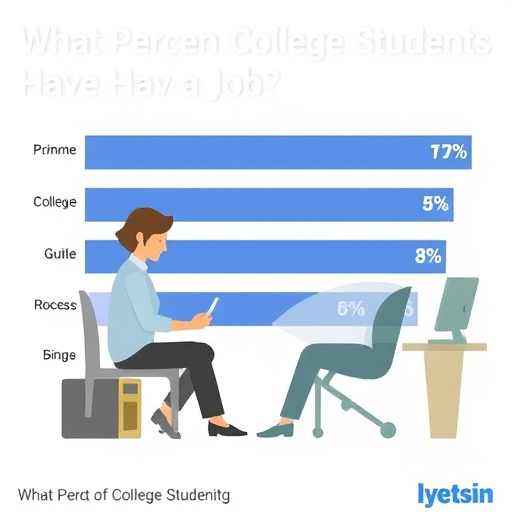What Percent of College Students Have a Job?
In the ever-evolving landscape of higher education, the question of employment among college students remains a critical topic. With rising tuition costs and increasing student debt, many students are compelled to seek employment while pursuing their degrees. This article delves into the current statistics regarding the percentage of college students who hold jobs, the types of jobs they typically take, and the implications of working while studying.
Understanding the Landscape of Student Employment
The Importance of Employment for College Students
Working while attending college can provide students with numerous benefits, including:
- Financial Support: Earning an income can help cover tuition, books, and living expenses.
- Work Experience: Gaining practical experience in a relevant field can enhance a student’s resume.
- Time Management Skills: Balancing work and studies can develop essential organizational skills.
- Networking Opportunities: Jobs can provide connections in a student’s field of interest.
- Type of Institution: Employment rates differ between community colleges, public universities, and private institutions.
- Academic Major: Certain majors may offer more opportunities for part-time work in related fields.
- Year in School: Freshmen may work less than seniors who are more focused on gaining experience.
- On-Campus Jobs: Positions such as library assistants, research aides, or dining hall staff.
- Retail Positions: Many students work in grocery stores, clothing shops, or restaurants.
- Internships: Paid or unpaid positions in students’ fields of study provide invaluable experience.
- Freelance Work: Some students leverage skills (like graphic design or writing) to find freelance gigs.
- Tutoring: Students often take up tutoring jobs, especially in subjects they excel in.
- Financial Necessity: Students from lower-income families may need to work more hours to afford their education.
- Scholarship Requirements: Some scholarships require recipients to maintain employment.
- Career Goals: Students may seek jobs related to their fields to gain experience and build networks.
- Personal Preferences: Some students prioritize work experience, while others focus solely on academics.
- Time Constraints: Juggling work and classes can lead to time management challenges.
- Stress Levels: Increased responsibilities can contribute to higher stress levels.
- Study Time: Limited time for studying can affect grades and learning outcomes.
- Set a Schedule: Create a weekly schedule that includes time for work, classes, and study.
- Communicate with Employers: Be open about your academic commitments with your employer.
- Prioritize Tasks: Use tools like planners or apps to keep track of deadlines and responsibilities.
- Seek Support: Utilize campus resources such as academic advisors or counseling services if feeling overwhelmed.
- Remote Work Opportunities: The rise of remote work options has opened doors for students to find flexible jobs.
- Gig Economy: Platforms like Uber, DoorDash, and Upwork allow students to take on freelance or part-time work based on their schedules.
- Internships and Experiential Learning: More students are seeking internships as a way to gain relevant experience, often leading to job offers post-graduation.
- Providing Job Resources: Career services can help students find part-time jobs, internships, and career fairs.
- Offering Flexible Class Schedules: Some institutions offer evening or online classes to accommodate working students.
- Creating Work-Study Programs: These programs allow students to work on campus as part of their financial aid package.
Current Statistics on College Student Employment
According to the National Center for Education Statistics (NCES), approximately 43% of full-time college students were employed in 2021. The percentage of students working can vary based on several factors, including:
Employment Rates by Student Type
| Student Type | Employment Rate |
|---|---|
| Full-Time Students | 43% |
| Part-Time Students | 80% |
| Graduate Students | 50% |
| Community College | 50% |
Types of Jobs Held by College Students
The types of jobs that college students typically hold can vary widely. Here are some common categories:
Factors Influencing Student Employment
Several factors can influence whether a college student chooses to work:
The Impact of Working on Academic Performance
Balancing Work and Studies
While working can provide benefits, it also poses challenges. Here are some potential impacts on academic performance:
Research Findings
Research indicates that moderate work hours may not negatively impact academic performance, but excessive hours can lead to decreased grades. According to a study by the American Council on Education, students who work less than 20 hours per week tend to perform better academically than those who work more than 30 hours.
Recommendations for Student Workers
To successfully balance work and studies, students should consider the following tips:
The Future of Student Employment
Trends in Student Employment
As we look to the future, several trends are emerging in student employment:
The Role of Universities
Colleges and universities play a crucial role in supporting student employment by:
Frequently Asked Questions (FAQ)
What is the average number of hours a college student works?
On average, college students work about 15-20 hours per week. However, this can vary significantly based on individual circumstances.
Do students who work perform worse academically?
Not necessarily. Students who work less than 20 hours per week often maintain good academic performance. However, excessive work hours can negatively impact grades.
What types of jobs are best for college students?
Jobs that offer flexibility, such as on-campus positions, internships related to the field of study, or freelance work, are often considered the best for college students.
How can students find jobs while in college?
Students can utilize campus career services, job boards, networking opportunities, and online platforms like LinkedIn to find suitable employment.
Is it possible to manage a full-time job and full-time studies?
While it is challenging, some students successfully manage full-time jobs while studying full-time. However, it requires excellent time management and strong support systems.
Conclusion
Understanding the percentage of college students who work and the implications of their employment is crucial in today’s educational environment. With approximately 43% of full-time students employed, it is evident that many are balancing academics and work. While working can provide valuable experience and financial support, students must manage their time effectively to maintain their academic performance. As trends evolve, the job landscape will continue to change, presenting new opportunities and challenges for future generations of students.
By recognizing the importance of work while studying, students can better prepare for their futures and make informed decisions about their careers and education.





